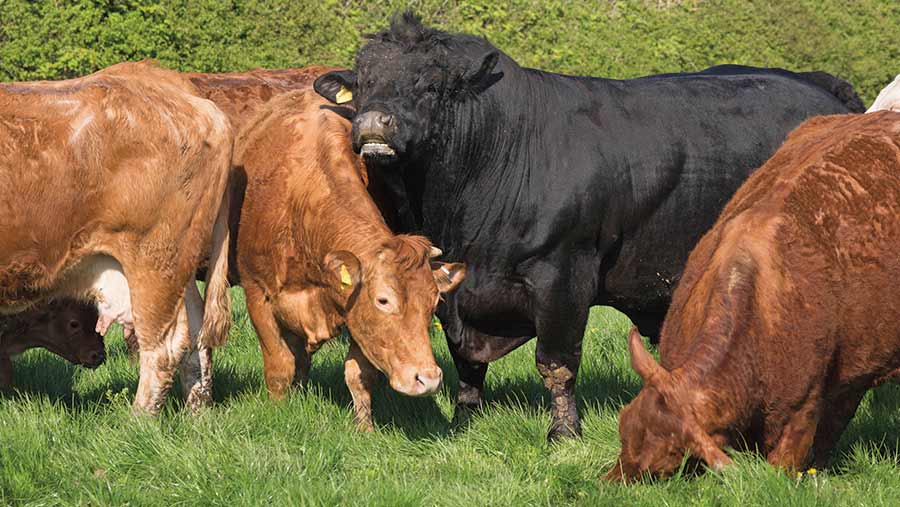How to select a sire for your suckler herd using EBVs
 © Tim Scrivener
© Tim Scrivener Selecting a sire with the right genetics can have a major impact on both performance and profitability of suckler herds.
To help farmers narrow down their decisions when it comes to obtaining a bull, Estimated Breeding Values (EBVs), which measure genetic potential, can be used to assess a bull’s breeding merit for a specifically desired trait.
Below, Max Tweedie, from Beef & Lamb Genetics New Zealand, talks through some of the most desired traits for suckler herds and how to select for them using EBVs.
What is an Estimated Breeding Value?
An Estimated Breeding Value is a measure of genetic potential, expressing the difference (positive or negative) between an individual animal and the individual breed benchmark.
Using EBVs, comparisons can be made between bulls of the same breed, but not different breeds.
A bull’s EBVs must be halved to estimate how much of his genetic superiority will be passed on to his progeny (as the dam makes up the other half of the calf’s genetics).
As an example, a bull with a 400 day weight EBV of +40kg will produce calves 20kg heavier at 400 days than a bull with an EBV of 0.
Calving attributes

Max Tweedie
Trait: Lighter calves at birth
Why do you want it?
Reducing the size of the calf at birth can help to minimise the risk of calving difficulties
EBV to target
Birthweight (kg) – Negative values = lighter calves at birth
Example
A bull with an EBV of -4kg is estimated to produce calves with birth weights 2kg lighter than a bull with a EBV of 0
Trait: More unassisted calvings
Why do you want it?
To minimise the human/vet intervention levels required during calving
EBV to target
Calving ease (%) – Positive values = more unassisted calvings of a bull’s direct progeny
Example
A bull with an EBV of 6 is estimated to produce 3% more unassisted calvings compared with a bull with an EBV of 0
Trait: Shorter gestation periods
Why do you want it?
The shorter the gestation period, the easier the calving tends to be because of the likelihood of lower birth weights
EBV to target
Gestation length (days) – Positive values = shorter gestations
Example
A bull with an EBV of -6 will produce calves with gestation lengths 3 days shorter than a bull with an EBV of 0
See also: How a beef farmer used EBVs to increase profit a cow by £360
Maternal traits
Trait: Increased milk production in female replacements
Why do you want it?
To produce milkier replacements that will wean heavier calves
EBV to target
200kg day milk (kg) – Positive values = more productive female replacements
Example
A bull with an EBV of +8kg will produce female progeny whose calves are 4kg heavier at 200 days than a bull with an EBV of 0.
Trait: Calving ease in the female line
Why do you want it?
To produce female progeny that are likely to calve without needing assistance
EBV to target
Maternal calving ease or calving ease daughters (%) – Positive values = daughters will have more unassisted calvings
Example
A bull with an EBV of 8 is estimated to produce daughters that will have 4% more unassisted calvings compared with a bull with an EBV of 0.
Growth and carcass attributes
Trait: Increased growth rates
Why do you want it?
To produce calves that grow and finish quicker
EBV to target
200 day growth (kg) or 400 day growth (kg) – Positive values = faster growth rates
Example
A bull with an EBV of +20kg is estimated to produce calves 10kg heavier at 200 days than a bull with an EBV of 0.
Trait: Leaner carcasses
Why do you want it?
To rear animals that can be taken to heavier weights without the risk of becoming over-fat
EBV to target
Backfat depth (mm) – Negative values = leaner carcasses
Example
A bull with an EBV of -2mm is estimated to produce calves with 1mm less fat across the loin than those of a bull with a 0 EBV.
Trait: Increased depth of loin
Why do you want it?
To increase the yield of lean meat in the carcass
EBV to target
Muscle depth (mm) or eye muscle area (sq cm) – Positive values = deeper loin muscles
Example
A bull with an EBV of +6mm is estimated to produce calves with 3mm more muscle across the loin than those of a bull with a 0 EBV.
Trait: Increased volume of saleable beef
Why do you want it?
To produce progeny with higher yielding carcasses.
EBV to target
Retail beef yield (%) – Positive values = higher percentages of saleable beef.
Example
A bull with an EBV of +10% would be expected to produce progeny that would yield 5% more saleable beef in a 300kg carcass than a bull with an EBV of 0.
Selecting for profit
As well as the traditional genetic traits, AHDB has developed five new EBVs linked to traits that commercial farmers get paid for.
The new carcass traits are derived from abattoir data and have been developed by using more than seven million carcass records – representing about 30% of the national slaughter population.
The project has shown that estimates for carcass are highly heritable (see table below) and therefore beneficial for inclusion in genetic evaluation programmes.
The new EBVs include:
- Carcass weight – predicts carcass weight at a given slaughter age
Example: A bull with a carcass weight EBV of +10kg will produce progeny that have 5kg heavier carcasses than a bull with a carcass weight EBV of 0.
- Carcass conformation – predicts carcass conformation at a given slaughter age
Example: A bull with a carcass conformation EBV of +9 will produce progeny that have conformation half a grade higher than a bull with a carcass conformation EBV of 0.
- Carcass fat class – indicates carcass fat class at a given slaughter age
Example: A bull with a fat class EBV of -6 will produce progeny that are half a grade lower (leaner) than a bull with a fat class EBV of 0.
- Days to slaughter – predicts days to slaughter at a given weight and fat class
Example: A bull with a days to slaughter EBV of -20 will produce progeny that reach slaughter 10 days earlier than a bull with a days to slaughter EBV of 0.
- Average daily carcass gain (ADCG) – an indicator of the daily gain in the carcass
Example: A bull with an ADCG EBV of +0.2kg will produce progeny that have a daily carcass gain 0.1kg greater than a bull with an EBV of 0.
While these EBVs can have great value, they can only be generated if farmers record the ear tag number of the sire when registering a calf with BCMS.
A new campaign from AHDB – #shoutaboutthesire – is urging farmers to ensure they are recording data to increase the accuracy of these EBVs going forward.
Heritability of different traits
Heritability scores indicate the probability of a specific trait being inherited – giving farmers an accurate idea of how likely the trait is to appear in the progeny.
Trait |
Heritability |
|
Carcass weight |
0.40 |
|
Carcass conformation |
0.41 |
|
Carcass fat class |
0.45 |
|
Days to slaughter |
0.63 |
|
source: AHDB |
|
Balancing trait selection
When it comes to using EBVs, balance is key and the entire production picture must be analysed to optimise profits, advises Seth Wareing, business manager for the Stabiliser Cattle Company.
“It’s not just about the end price – but what it took to get the animal there. Mature cow size, fertility, age at first calving, feed efficiency and growth rates are just a few of the economical traits that must be considered when selecting breeding stock.”
When these genetic traits are not balanced producers run a high risk of jeopardising herd profitability.
For example, single trait selection for growth may result in profit loss due to calving issues, while single trait selection for calving ease may result in profit loss due to low growth rates.
To simplify trait selection while maintaining balance, Mr Wareing recommends beef producers do two things:
- Utilise Selection Indexes to make initial sire selections. Selection indexes mathematically weigh EBVs into a single figure to give it an economic weighting. Standard Selection Indexes are now available for most breeds. Once the selection is narrowed down, EBVs can then be used to identify which animal is most suitable.
- Consider the accuracy of EBVs: The higher the accuracy value the lower the likelihood of change. When deciding between bulls with similar EBVs, choose the one with higher accuracy.
